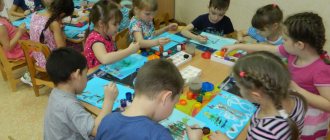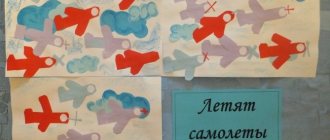Paints and brush
For example, it is worth paying attention to standard drawing supplies. We are talking about brushes and paints. Perhaps this option for conducting a lesson is suitable for both middle and senior groups. Very young children can also be entrusted with this kind of “inventory”. Only with great caution.
Let children paint their family using watercolor or gouache. It is also good to offer the guys an alternative to this method. Why? Maybe it will be more interesting for the child to draw and depict in some other way. The main thing in the lesson is the interest of the student and his involvement in the process. In addition, if all the children’s works are made from different “materials,” then it will even be possible to organize an exhibition at the end. She will definitely be remembered by her parents.
Theme of the week: “Professions”
Lesson 25. Railway for Doctor Aibolit
(Brush painting. Gouache)
Target. Teach children to draw long and short intersecting lines using a brush. Create a desire to help those who need help.
Demonstration material. Toys – owl, steam locomotive, trees.
Handout. Rectangular card (landscape sheet cut in half along the long axis); gouache, brush.
Progress of the lesson
Play out the situation: an owl has flown in from the forest and is crying. It turns out her owlets are sick.
Tell the children: “Doctor Aibolit is on the train to help, but the railway has ended. Let’s continue the road so that the train (show the toy locomotive) with the doctor can travel into the forest.”
Take a rectangular card, draw parallel lines on it - these are rails - and short perpendicular lines - these are sleepers. Give the children the rest of the cards and ask them to draw the rails and sleepers. Show the kids how to correctly hold the brush with three fingers in the middle, dip it in water and pick up paint only onto the bristles.
When the children's drawings are ready, put the cards in a row - you get a road to a toy forest; Together with the kids, send a toy train with Doctor Aibolit and an owl on the railway.
At the end of the lesson, on behalf of the owl, thank the guys for their help.
Organization
The whole process needs to start with its proper organization. The success of a lesson lies in planning. This also applies to activities such as drawing in preschool educational institutions. “My family” is a fascinating topic; a lesson dedicated to it should begin with a short dialogue between the teacher and the kids.
It is best to use various rhymes and short stories about the family as an introduction. This technique will attract the children to the topic and also interest them. In addition, use songs on the chosen topic. They also have a beneficial effect on the general atmosphere of the lesson.
Then it is advisable to conduct a dialogue with the kids on the topic of their family. Let each child tell who lives with him and who he loves. After all, it is not only drawing that is important in preschool education. “My Family” is a topic that will not only help develop children’s artistic abilities, but will also contribute to the development of speech.
The next stage, perhaps the most interesting, is the children’s direct depiction of their family. Offer them a variety of materials to implement their plans. If time allows, you can use more than just paper and pencils. How interesting is it to organize drawing in a preschool educational institution? “My family” is the topic of the planned lesson.
Pencil
And we continue our drawing with you at the preschool educational institution. “My family” is a favorite and popular topic that should interest a child. If kids don’t really like brushes and paints, then offer them pencils.
Perhaps it is precisely this kind of technique that allows classes to be conducted in all groups. While the youngest pupils may not yet “make friends” with brushes and paints, everyone is familiar with colored pencils. So it is better that each child has a set with this “equipment” on the table.
Tasks and goals
Any activity in kindergarten has its own tasks and goals. They are important for the entire educational process. It’s not just that a drawing lesson on the topic “My Family” or “My Pet” is held. It all makes some sense. In addition to developing hand motor skills, of course.
In our case, this lesson will be held in order to summarize all the knowledge acquired about the family and its composition. It is advisable to conduct this kind of lessons with all kids. But special emphasis needs to be placed on the senior preparatory group.
In addition, drawing in a preschool educational institution on the topic “My Family” should teach the child to depict a person: proportions, facial features, differences between people.
Of course, there is a developmental element here too. The child learns to remember information, analyze it, and then express it in drawings. Plus, drawing in kindergarten (“My family” is the chosen topic) should teach the child to treat his family with care and attention.
Plasticine
Perhaps the most interesting approach to conducting our lesson today will be the use of plasticine and cardboard. With the help of these “devices”, oddly enough, you can also draw.
How? Let your child draw a drawing of his family using a pencil on cardboard. But he will color it with plasticine heated in his hands. This kind of drawing in preschool educational institutions (“My family” is the chosen topic) is often used in junior and middle groups. An interesting technique, but not all educators approve of it. And in vain.
The point is that this particular version of drawing can attract even the restless person. After all, a drawing painted with plasticine is so much fun! The child’s interest should be the main component of the lesson. Let the children choose how they want to draw. If there are any difficulties, help the students. But remember - they must create themselves. And color your drawings too.
Topics and conversations
For the senior preparatory group in kindergarten, you can conduct several drawing classes on the topic “My Family.” With all this, it’s enough just to diversify the methodology proposed above a little to get interesting and useful activities.
For example, let the guys bring photographs and tell them who is depicted in them. After that, let them draw and depict the family in all available ways. Plus, organize activities like “I’m helping mom,” “I’m going for a walk with dad,” “Family vacation,” and so on. Let children develop their imagination and learn to depict reality.
By the way, don’t forget to hold a variety of thematic exhibitions at the end of each lesson. Sometimes you can invite a child psychologist to them. After all, a child’s drawing of a family can say a lot about the atmosphere in it, as well as the relationships with its members. This is very important for the correct and correct development of the child. If you notice any obvious signs of anxiety in a student, which are expressed through a drawing, invite the parents to an individual conversation. In principle, it is generally better to hold parent meetings after drawing on the topic “My Family”, at which you will explain why the child drew each specific family member in one way or another. All this will help the child's development. Drawing in kindergarten on the theme “My Family” is an important learning process that should not be skipped. Give it due attention.
Theme of the week: “Defender of the Fatherland Day”
Lesson 23. Russian flag
(Colour pencils)
Target. Teach children to draw rectangular objects and carefully paint over them. Activate the words “army” and “flag” in your speech.
Demonstration material. Russian flag (small).
Handout. Landscape sheet, simple pencil, colored pencils.
Progress of the lesson
Tell the children: “Each country has its own army and flag. Military people serve in the army. If our country is attacked by enemies, they will defend it with arms in hand. Our country is called Russia. Here is the flag of our country. (Show the flag.) It is rectangular in shape and consists of three stripes: the top is white, the middle is blue, the bottom is red. Each country has its own flag."
Read the poem by S. Marshak to the children:
The fleet is sailing to its native land.
A flag on every ship.
Invite the children to depict the Russian flag. First, they must use a simple pencil to draw a stick on which the flag will be held. You need to draw a rectangle on the side and divide it into three parts. Then carefully paint over the stripes with white, blue and red pencils.
At the end of the lesson, ask the children: “Why should every country have its own flag?” (To distinguish whose army, whose ship.)
Topic of the week: “My Home”
Lesson 22. Fence near the house
(Brush painting. Gouache)
Target. Continue to teach children to draw various objects consisting of combinations of lines. Learn to retell fairy tales based on illustrations in the book. Develop speech and thinking.
Demonstration material. Toys are the heroes of the fairy tale “The Hare's Hut” (hare, fox, bull, dog, bear and rooster).
Handout. A landscape sheet on which a hut is drawn, gouache, a brush, a jar of water.
Progress of the lesson
Read the Russian folk tale “The Hare’s Hut” to the children in advance. During class, remember the fairy tale based on the pictures in the book, or dramatize this fairy tale for the children.
Invite the children to draw a fence around his hut so that the fox can no longer get to the bunny. Ask: “What should the fence be like?” (Long, tall, yellow (or any other color).)
Near the house, children draw two long horizontal lines with a brush, and short lines perpendicular to them - picket fences.
Tell the guys: “The fence turned out well! Now the bunny is not afraid of the fox!”
Applications
The next option, which is suitable for older children, is to use appliqués to depict your family. For example, using colored paper, cardboard, glue and scissors. In truth, it is precisely this kind of “drawing” in a preschool educational institution (“My family” is its theme) that causes great delight in children. After all, this is how a child not only learns to portray his family, but also develops fine motor skills.
Make sure that each child also has glue, scissors, cardboard and colored paper. Maybe the kids will want to choose exactly this method of depicting reality. You shouldn't stop them from doing this. Yes, this is not direct drawing on paper, but this method also corresponds quite well to the goals and objectives set. The child will still portray his family, albeit in a somewhat non-standard form.



